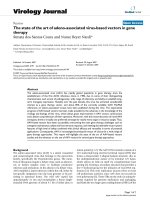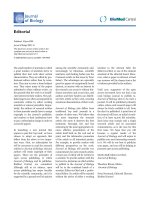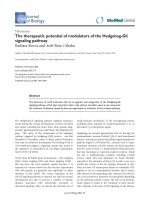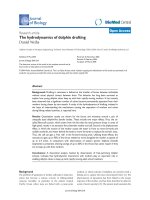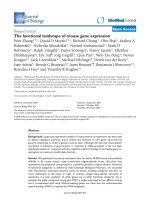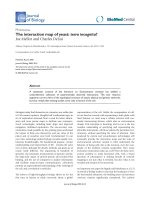Báo cáo sinh học: "The gene complement of the ancestral bilaterian - was Urbilateria a monster" potx
Bạn đang xem bản rút gọn của tài liệu. Xem và tải ngay bản đầy đủ của tài liệu tại đây (306.8 KB, 4 trang )
Miller and Ball: Journal of Biology 2009, 8:89
Abstract
Expressed sequence tag analyses of the annelid Pomatoceros
lamarckii, recently published in BMC Evolutionary Biology, are
consistent with less extensive gene loss in the Lophotrochozoa
than in the Ecdysozoa, but it would be premature to generalize
about patterns of gene loss on the basis of the limited data
available.
See research article />The pioneers of pyrosequencing have a lot to answer for.
The availability of ‘next generation’ DNA sequencers has
provided zoologists with unforeseen opportunities to
address many basic evolutionary issues and, for those of us
whose interests lie beyond the model organisms, these are
indeed interesting times. Not so long ago the costs of large-
scale expressed sequence tag (EST) analyses were
prohibitive, but the recent development of the fast and
(relatively) cheap 454, Illumina and SOLiD technologies is
enabling large-scale transcriptome analysis, and poten-
tially whole-genome analysis, to be applied to a wide range
of animals, providing insights into evolutionary issues that
were once considered essentially intractable.
One important and controversial issue that can now be
addressed is the gene complement of Urbilateria. It is clear
that this ancestor of all bilateral animals had a genome
resembling that of a modern vertebrate, but which also
contained some genes lost from modern vertebrates, raising
the issue of just how many genes were present in the
ancestor. In this respect, EST studies on lophotrocho zoans,
such as that reported in a recent paper in BMC Evolutionary
Biology [1], are proving particularly infor mative. Of the
three major divisions within Bilateria (the Ecdysozoa, the
Lophotrochozoa and the Deuterostomia; Figure 1), Lopho-
trochozoa, which contains the annelids (worms) and
mollusks (including snails) and various minor phyla, is still
only poorly represented in terms of whole genome data.
One implication of work on the annelid Platynereis
dumerilii is that lophotrochozoans may be less derived (are
more representative of ancestral character states) than
members of Ecdysozoa [2], but it is not yet clear how
representative Platynereis is. Takahashi et al. [1] have now
analyzed a set of ESTs from a second and only distantly
related annelid, the serpulid Pomatoceros lamarckii,
which differs from Platynereis both morphologically and
in lifestyle. Platynereis is a free-living predator, whereas
Pomatoceros lives within a tube that it constructs and
captures food from the surrounding waters using a crown
of feeding tentacles through which water is filtered.
Nevertheless, data from the two species lead to the same
conclusion, that annelids (and perhaps lophotrochozoans
in general) are less derived than the insects and nematodes
investigated so far. One focus of the paper [1] was patterns
of gene sharing and gene loss between Pomatoceros and
the other major groups of organisms. These figures are
summarized in Figure 1: Pomatoceros shares a significant
number of genes (158; 7% of the total) only with deutero-
stomes and other lophotrochozoans, but a much smaller
number (23 genes; 1% of the total) only with ecdysozoans
and other lophotrochozoans. In addition, 11 genes shared
only with non-bilaterians were identified, illustrating the
ubiquity of gene loss.
The significance of cnidarians for
understanding the urbilaterian gene
complement
Although the genome of a choanoflagellate (thought to be
the closest living relatives of the animals) [3] showed us
that some ‘animal-specific’ genes came earlier in evolution,
many other genes really are unique to meta zoans, and
these include components of several signaling pathways
(such as the Wnt, transforming growth factor β and nuclear
hormone receptor pathways). When the genomes of
bilaterians are compared with those (admittedly, as yet few)
available for ‘lower’ (non-bilaterian) animals, one fact that
clearly stands out is that a quantitative leap in terms of
signaling molecule complexity preceded the emergence of
the Cnidaria (the phylum that includes hydras, sea
anemones, corals and jellyfish). Whereas most or all of the
animal-specific signaling systems seem to be present in the
genomes of Porifera (sponges) and Placozoa (placozoans;
very simple animals with only three or four distinct cell
Minireview
The gene complement of the ancestral bilaterian - was Urbilateria
a monster?
David J Miller* and Eldon E Ball
†
Addresses: *ARC Centre of Excellence for Coral Reef Studies and Comparative Genomics Centre, James Cook University, Townsville,
Queensland 4811, Australia.
†
Centre for Molecular Genetics of Development and School of Biology, Australian National University, Canberra,
ACT 2601, Australia.
Correspondence: David Miller. Email:
89.2
Miller and Ball: Journal of Biology 2009, 8:89
types), they are much less highly elaborated than in
cnidarians or bilaterians. For example, whereas the sea
anemone Nematostella has 12 Wnts, most of which are
recognizable as homologs of specific Wnt types known
from bilaterians [4], the sponge Amphimedon and the
placozoan Trichoplax each have only three Wnts that are
not easily assignable. In addition, these lower animals
seem to have much less well developed arsenals of
signaling molecule antagonists. The situation with respect
to transcription factors is a little less clear cut but, for
example, the homeobox gene complement of Nematostella
is much more bilaterian-like than are those of sponges and
placozoans [5]. In summary, cnidarians seem to be
particularly important in terms of under standing the
urbilaterian gene repertoire.
Have lophotrochozoans lost fewer genes?
There is a widespread perception that ecdysozoans have
lost more of the ancestral gene set than have deuterostomes
or lophotrochozoans. This notion has its roots in early
comparisons (for example, [6]) between cnidarians, verte-
brates and the model ecdysozoans (fly and nematode
worm), which clearly demonstrated that gene loss was
much more extensive in Drosophila and Caenorhabditis
than in verte brates. Since that time, genome data have
become available for a broader range of species, so to what
extent does this generalization still hold? Is it possible (or
meaningful) to generalize - have ecdysozoans in general
lost more genes than lophotrochozoans or deuterostomes,
or do we still have too few whole genome sequences to be
able to say?
Figure 1
A simplified view of animal phylogeny, showing the taxonomic position of groups and organisms mentioned in the text (genera are in italics).
Taxa above the red line are animals. Relationships among the non-bilaterian phyla remain controversial, but the topology shown reflects the
current consensus. Numbers in red are percentages of the total number (2,308) of Pomatoceros ESTs with matches against specific
taxonomic groups. Numbers on the boundaries between taxonomic groups are shared exclusively between Pomatoceros and those groups,
whereas in the cases of non-bilaterians and bacteria/protists the numbers reflect ESTs shared between Pomatoceros, lophotrochozoans and
those taxonomic groups. For example, 7% of Pomatoceros ESTs are shared only with lophotrochozoans and deuterostomes, and less than
1% are shared only with lophotrochozoans and non-bilateral animals or with lophotrochozoans and bacteria or protists. Over half (1,205;
52%) of the total number of Pomatoceros ESTs had no matches in the databases.
7%
35%
Deuterostomes
Bilateria
Ecdysozoans
1%
4%
Bacteria and Protists
<1%
<1%
non-Bilateria
Chordata
Tetraodon
Hemichordata
Echinodermata
Brachiopoda
Mollusca
Annelida
Pomatoceros, Platynereis
Nemertea
Platyhelminthes
Schistosoma
Arthropoda
Drosophila, Tribolium, Apis
Nematoda
Caenorhabditis, Brugia, Meloidogyne, Pristionchus
Cnidaria
Nematostella, Hydra
Placozoa
Trichoplax
Porifera
Amphimedon
Lophotrochozoans
89.3
Miller and Ball: Journal of Biology 2009, 8:89
There are now whole-genome data for over 20 insect
species (this includes 12 Drosophila species) and a handful
(5) of nematodes. Comparisons between insects and verte-
brates (for example, [7]) indicate that gene loss is largely a
function of rates of evolution and divergence times, and
does not discriminate between vertebrates or insects.
Among insects, Drosophila has a particularly high rate of
evolution, whereas the beetle Tribolium and the honeybee
Apis have lower rates of evolution and have lost fewer of
the ancient genes present in Urbilateria. Although
vertebrates in general have lost fewer ancient genes, the
chicken is a clear outlier, having lost more genes in the
‘universal single-copy orthologs’ and ‘universal multi-copy
orthologs’ categories than any of the five insects included
in the Wyder et al. analysis [7]. Moreover, whereas the two
Caenorhabditis species and the parasitic species Brugia
malayi and Meloidogyne hapla all show the ‘typical’
ecdysozoan pattern of extensive gene loss, a fifth nematode
species, Pristionchus pacificus, is not so reduced [8].
What about lophotrochozoans? Whole genome sequences
have been determined for seven genera (eight species; two
Schistosoma species), but so far very few large-scale
analyses have been published. The idea that the genomes
of lophotrochozoans are less derived than those of ecdyso-
zoans comes largely from work on the annelid P. dumerilii,
which shows that this organism is closer to vertebrates
than to ecdysozoans in intron structure and retention, and
in protein coding sequence similarity (see, for example,
[2]). The only lophotrochozoans with sequenced and ana-
lyzed genomes, Schistosoma mansoni and S. japonicum,
are both parasitic platyhelminths, which, consistent with
other parasites, have undergone extensive gene loss and
divergence. Thus, they can hardly be considered repre-
sentative of phyla consisting mostly of free-living forms.
There are bound to be derived lophotrochozoans, just as
there are derived ecdysozoans and derived deuterostomes.
So, although this limited sample of two annelids [1] is
consistent with greater gene loss in Ecdysozoa than in
Lophotrochozoa, it is still very early days, and it would be
premature to yet draw general conclusions. We await with
interest the analysis and publication of more
lophotrochozoan genomes, particularly those of free-living
flatworms, mollusks, and some of the smaller phyla, such
as bryozoans, nemertines and brachiopods.
Any gene can go
One surprising implication of comparative genomics is that
no gene is indispensable; every animal seems to have lost
hundreds of what one might have assumed were ‘core
requirement’ genes. For example, Wyder et al. [7] report
that 40% of ancient orthologous genes were lost in a least
one of the ten animals included in their analysis (five insects
and five vertebrates). One example of loss of a core gene is
the case of the Toll receptor in Hydra magni papillata.
Whereas Nematostella and other members of the basal
cnidarian class Anthozoa have a canonical Toll receptor,
Hydra (which is a member of the more derived class
Hydrozoa) has lost this gene [9]. Hydra seems to have
undergone non-orthologous gene replacement, Toll receptor
function being fulfilled by two unrelated proteins [10].
Evolution sometimes dispenses with whole pathways, for
instance the entire DNA methylation system in the case of
dipterans (flies and mosquitoes).
Inferring the ancestral complement - was
Urbilateria a monster?
All animals have lost genes, but it does not follow that
Urbilateria was a monster in terms of gene content.
Bilaterian animals typically have around 20,000 genes
(range 11,500 to 28,000; Meloidogyne to Tetraodon), but
a substantial fraction of these are taxonomically restricted
at some level. Many of these taxonomically restricted genes
are paralogs or highly diverged members of large gene
families, generated by duplication events that have
occurred at all levels. On the basis of the currently available
data, the core bilaterian gene set probably contained fewer
than 10,000 genes, the caveat being that the available data
are rather limited. Taxonomic gaps need to be plugged,
and more data for non-bilaterians in particular will be
critical in revealing the genomic makings of Urbilateria.
Far too few whole-genome sequences are yet available for
firm estimates to be made, but it is clear that there is no
need to invoke monsters - either hopeful or hopeless.
References
1. Takahashi T, McDougall C, Troscianko J, Chen W-C,
Jayaraman-Nagarajan A, Shimeld SM, Ferrier DEK: An EST
screen from the annelid Pomatoceros lamarckii reveals
patterns of gene loss and gain in animals. BMC Evol Biol
2009, 9:240.
2. Raible F, Tessmar-Raible K, Osoegawa K, Wincker P, Jubin C,
Balavoine G, Ferrier D, Benes V, de Jong P, Weissenbach J,
Bork P, Arendt D: Vertebrate-type intron-rich genes in the
marine annelid Platynereis dumerilii. Science 2005, 310:
1325-1326.
3. King N, Westbrook MJ, Young SL, Kuo A, Abedin M, Chapman
J, Fairclough S, Hellsten U, Isogai Y, Letunic I, Marr M, Pincus
D, Putnam N, Rokas A, Wright KJ, Zuzow R, Dirks W, Good M,
Goodstein D, Lemons D, Li W, Lyons JB, Morris A, Nichols S,
Richter DJ, Salamov A, JGI Sequencing, Bork P, Lim WA,
Manning G, et al.: The genome of the choanoflagellate
Monosiga brevicollis and the origin of metazoans. Nature
2008, 451:783-788.
4. Kusserow A, Pang K, Sturm C, Hrouda M, Lentfer J, Schmidt
HA, Technau U, von Haeseler A, Hobmayer B, Martindale MQ,
Holstein TW: Unexpected complexity of the Wnt gene family
in a sea anemone. Nature 2005, 433:156-160.
5. Larroux C, Luke GN, Koopman P, Rokhsar DS, Shimeld SM,
Degnan BM: Genesis and expansion of metazoan transcrip-
tion factor gene classes. Mol Biol Evol 2008, 25:980-996.
6. Kortschak RD, Samuel G, Saint R, Miller DJ: EST analysis of
the cnidarian Acropora millepora reveals extensive gene
loss and rapid sequence divergence in the model inverte-
brates. Curr Biol 2003, 13:2190-2195.
7. Wyder S, Kriventseva EV, Schröder R, Kadowaki T, Zdobnov
EM: Quantification of ortholog losses in insects and verte-
brates. Genome Biol 2007, 8:R242.
89.4
Miller and Ball: Journal of Biology 2009, 8:89
8. Dieterich C, Clifton SW, Schuster LN, Chinwalla A, Delehaunty
K, Dinkelacker I, Fulton L, Fulton R, Godfrey J, Minx P, Mitreva
M, Roeseler W, Tian H, Witte H, Yang SP, Wilson RK, Sommer
RJ: The Pristionchus pacificus genome provides a unique
perspective on nematode lifestyle and parasitism. Nat
Genet 2008, 40:1193-1198.
9. Miller DJ, Hemmrich G, Ball EE, Hayward DC, Khalturin K,
Funayama N, Agata K, Bosch TC: The innate immune reper-
toire in Cnidaria - ancestral complexity and stochastic
gene loss. Genome Biol 2007, 8:R59.
10. Bosch TC, Augustin R, Anton-Erxleben F, Fraune S, Hemmrich
G, Zill H, Rosenstiel P, Jacobs G, Schreiber S, Leippe M,
Stanisak M, Grötzinger J, Jung S, Podschun R, Bartels J,
Harder J, Schröder JM: Uncovering the evolutionary history
of innate immunity: the simple metazoan Hydra uses epi-
thelial cells for host defence. Dev Comp Immunol 2009, 33:
559-569.
Published: 19 November 2009
doi:10.1186/jbiol192
© 2009 BioMed Central Ltd

